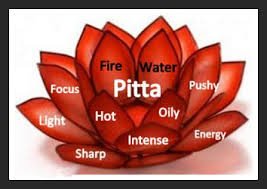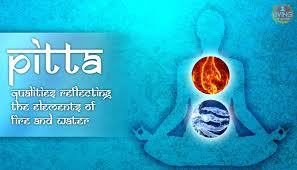

PITTA and its 5 SubTypes
The Pitta dosha consists of the 2 Panchamahabhutas (5 great elements)Agni(Fire) and Jal(Water). Pitta has Sattva qualities and is responsible for transformation and transforms raw materials to useful energy.
Digestion, tissue metabolism, body temperature, vision, hunger, courage, bravery, fear, anger, ignorance, delusion and retention of memory all relate to this dosha and is primarily located between stomach and large intestine. With an increase of Pitta, conditions like Hyper-Thyroidism, yellow eyes, urine, skin and stools may occur along with increased hunger, thirst and heat, burning sensations through the body, and a desire for a cool environment and diet. With decreased Pitta you will experience Hypo-Thyroidism, decreased heat in the body, decreased appetite and loss of mobility.
Pitta is also represented by the middle third of our body and the mid age of our lives. The times of Pitta are 10am to 2pm and 10pm to 2am.
Pitta Subtype 1) Sadhak Pitta- is our brain and heart connection and governs mental energy and mental digestive capacity to the nervous system and senses. It has an inward movement and is primarily seated in the brain. Sadhak Pitta directs our intelligence, governs our inner combustion, governs the release of energy from our impressions and gives us the power of discrimination, lack of Sadhak Pitta will cause confusion.
Pitta Subtype 2) Alochak Pitta- is responsible for our vision and is located in our eyes and has an upward motion. It governs our visual perception and is also responsible for the reception of light.
Pitta Subtype 3) Panchak Pitta- is our digestive fire and is located in the intestines. It governs the power of digestion, regulates the body temperature, maintains the power circulation, separates nutrients from food, aids in tissue building and has an anabolic function. Panchak Pitta has equalizing and balancing actions and is the first consideration in the treatment of Pitta because it is the basis and support of the Pitta subtypes.
Pitta Subtype 4) Bhrajak Pitta- maintains complexion, colour and tone of skin and also is located in the skin, governs the warmth/heat absorbed via the skin. Can be referred to as your “natural glow”
Pitta Subtype 5) Ranjak Pitta- located in the liver, small intestine, spleen, and stomach, it resides in the blood as well and has a downward motion. Ranjak Pitta gives colour to the blood, bile, and stool and is also has a big role in the warmth of the blood in the circulatory system.

